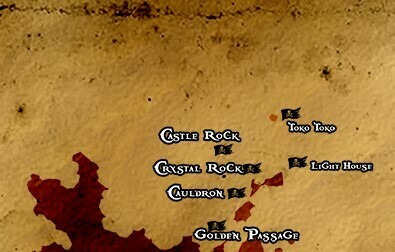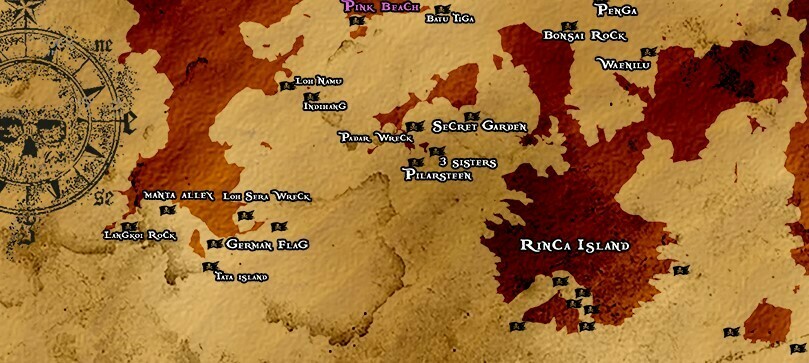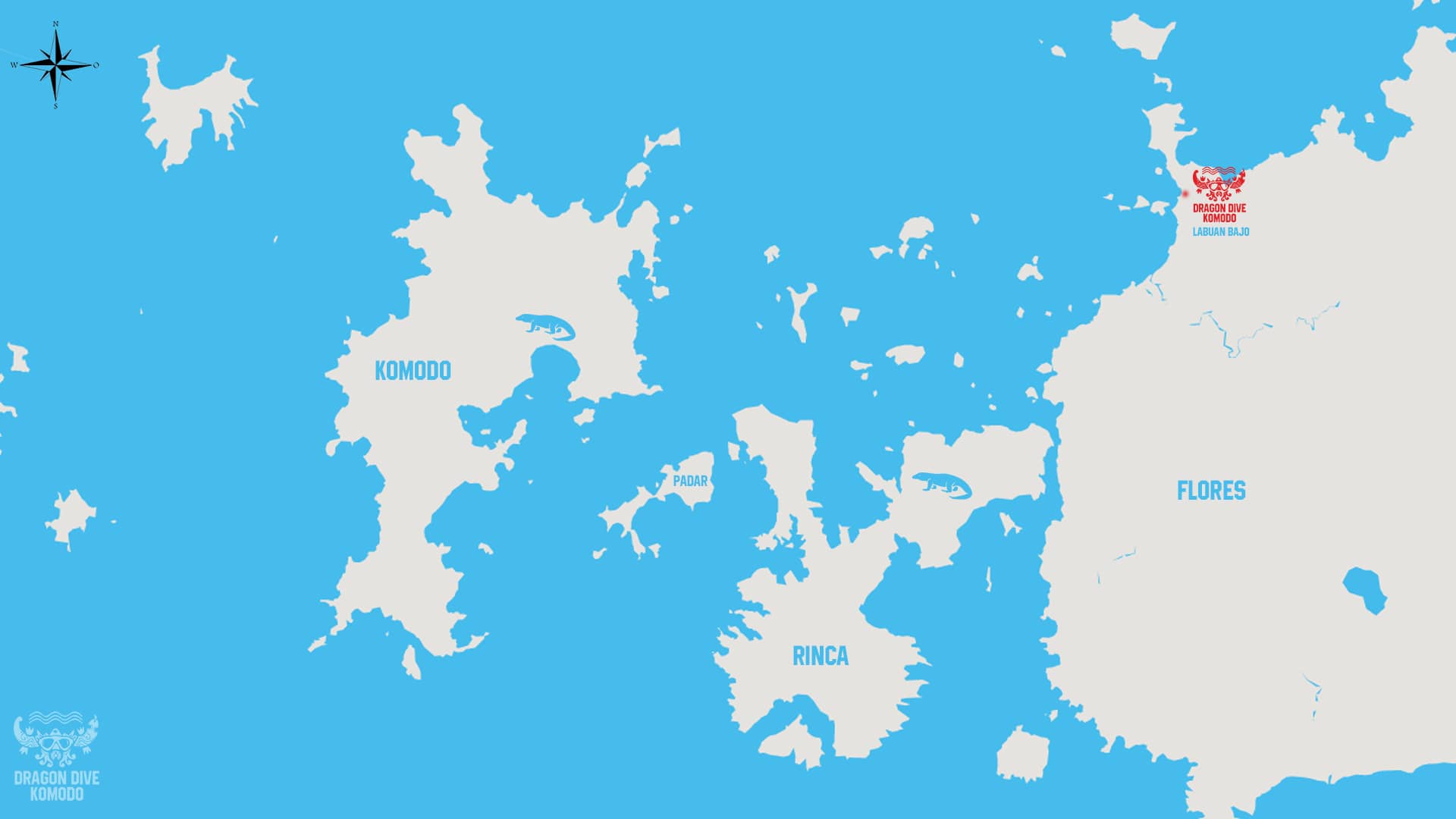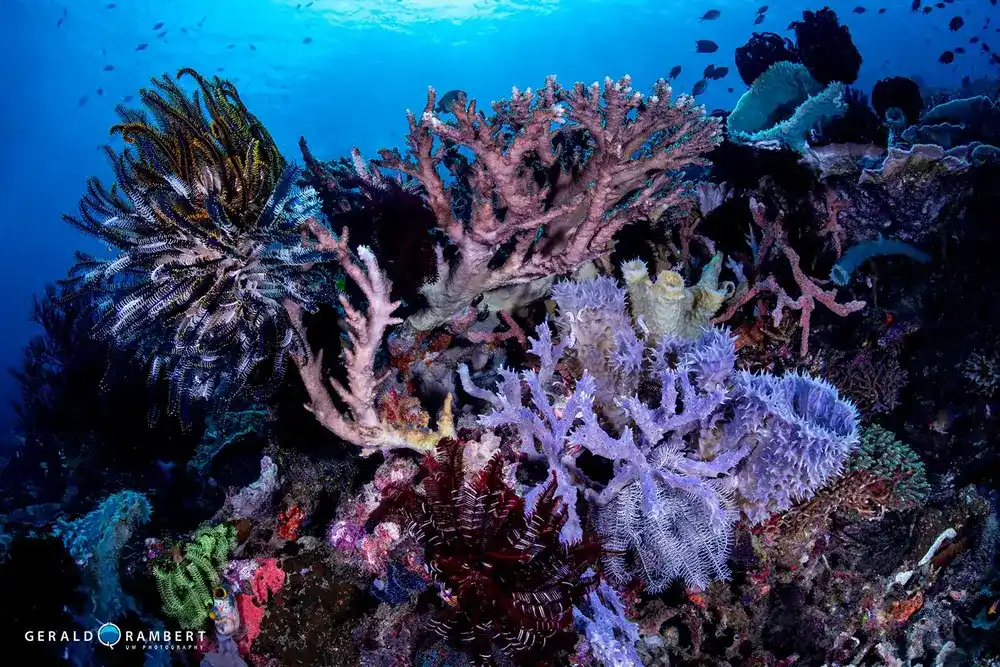Komodo Dive Sites — Map, Seasons & Difficulty
Plan your dives across North, Central, South Komodo: from Batu Bolong to Castle/Crystal Rock, Manta Point, Shotgun, Manta Alley & more. Clear tips on currents, depths, and best months for each site.
When to Dive in Komodo
The diving season in Komodo National Park runs from April to November, with optimal conditions from May to October. Experience warm water temperatures, crystal-clear visibility, and moderate currents during this prime diving window.
April - June
Excellent visibility and comfortable water temperatures. Perfect for most divers with ideal conditions for underwater photography.
July - September
Peak visibility period with slightly cooler water. Best time for crystal-clear underwater views and optimal diving conditions.
October - November
Good diving conditions with occasional reduced visibility. Still excellent for marine life encounters.
Manta Season
December - March offers the best manta ray encounters, though sightings are possible year-round in Komodo waters.
Unique Komodo Diving Experiences
Diving with Manta Rays
Experience the magic of swimming alongside majestic manta rays in Komodo National Park. These gentle giants frequent the cleaning stations and feeding areas throughout the park. Best visibility during dry season (April-December) makes encounters even more spectacular. Suitable for divers of all levels seeking an unforgettable underwater adventure.
Komodo Dragons on Land
After exhilarating dives, encounter the famous Komodo dragons in their natural habitat. This UNESCO World Heritage Site protects these magnificent prehistoric creatures. Combined land and sea adventures offer breathtaking landscapes and unique wildlife encounters. Multiple dive sites provide access to both marine wonders and terrestrial dragons.
Macro Diving Treasures
Discover Komodo's hidden macro diving treasures in vibrant coral ecosystems. Hunt for colorful nudibranchs, elusive seahorses, and intricate shrimp species. Each dive reveals nature's artistry in miniature forms, perfect for underwater photography. Specialized macro sites showcase incredible biodiversity often overlooked by casual divers.
Komodo Dive Sites by Region
Central Komodo Dive Sites
Year-Round Diving Paradise

Central Komodo represents the largest and most diverse diving region in Komodo National Park. This area offers incredible year-round diving with consistent conditions and easy accessibility. From encounters with graceful manta rays to discovering rare macro creatures, central Komodo delivers unparalleled diversity that will delight divers of all experience levels.
North Komodo Dive Sites
Power Diving & Big Marine Life

North Komodo hosts some of the most famous and challenging dive sites in the park, including The Cauldron (Shotgun), Castle Rock, and Crystal Rock. This region is renowned for powerful currents, large pelagic species, and spectacular schools of fish. Hidden gems like Crystal Bay and Chinese Shop offer incredible macro diving and juvenile manta ray sightings.
Minimum 4 divers required. Supplement fee of 500,000 IDR split between guests if fewer than 4 divers.
South Komodo Dive Sites
Exclusive Adventures & Pristine Reefs

Dragon Dive is the only operator offering daily access to South Komodo's pristine dive sites. Explore Padar Island, Nusa Kode (South Rinca), and South Komodo aboard our vessel Smaug. This remote region features Pillarsteen, Secret Garden, Cannibal Rock, and Yellow Wall on South Rinca, plus Manta Alley, End of the World, and Tanjung Low Sera on Komodo Island.
Early 5 AM departure for 2-3 day trips. Minimum 4 divers required. Supplement fee of 1,000,000 IDR split between guests if fewer than 4 divers.
Ready to Explore Komodo's Best Dive Sites?
Book your unforgettable diving adventure in Komodo National Park today. Experience manta rays, dragons, and world-class dive sites with expert guides.
Book Your Komodo Diving AdventureKomodo DIve Spots
Komodo National Park offers you a unique underwater environment. The geographical position and the mix between the Indian and the Pacific Oceans make the diving conditions absolutely perfect, and spectacular. You will dive into a unique environment ultra-rich in biodiversity in the heart of the Coral Triangle.
Here you’ll find everything you ever wanted to see from giant pelagic life to unbelievable macro creatures in tropical, pristine water. You can see more than a hundred different species of fish, and go diving whilst accompanied by manta rays, sharks, dolphins and schools of tuna etc…
Below you will find the most popular komodo diving locations. There are more than 40 dive sites between the North and South of the park, and Dragon Dive Komodo offers 25+ all year round.

Komodo Dive Sites
Discover the Best Diving Spots in Komodo National Park
Central Dive Sites of Komodo

Manta Point
This is the most wanted dive site for diving guests! This dive is the main location in Komodo to find manta rays – often as many as 10 or 20 graceful giants gliding through the crystal-clear waters.

Batu Bolong
This world-famous dive site is a pinnacle that descends to more than 85 meters. Located in central Komodo between Tatawa Kecil island and Komodo island, this dive site is a real fish festival and consistently rated among the world's best diving locations.

Tatawa Besar
Tatawa Besar is 30 km east of Komodo and boasts one of the healthiest reefs. This is the home for many turtles, also watch out for the blacktip reef sharks, giant trevallies, and barracudas. Manta rays are also seen here occasionally.

Siaba Besar
Located near the dive site Batu Bolong, this dive site is turtle heaven. It is also an excellent spot for macro diving where you can spot some flamboyant cuttlefish, frogfish, hornet ghost pipe fish, sea moths, blue-spotted stingrays and stargazers.

Pengah
Located midway between Flores and Komodo, Pengah Kecil is a small island that can be dived on the north or south side. It shelters very rich marine life from tiny pygmy seahorses to reef sharks and eagle rays. The shallow part features one of the most beautiful coral gardens in Komodo National Park.

Tatawa Kecil
It's best to dive the west coast of this island to explore its vibrant shallow coral gardens full of anthias. Its caves and boulders are perfect harbors for larger groupers, creating an underwater landscape of incredible diversity.

Mawan
South-east of Manta point lies the island of Mawan. It is the second manta spot in Komodo National Park and could be the highlight of your trip. Although shallow, the dive site is prone to very strong currents that attract dozens of mantas looking for cleaning stations.

Police Corner
At the southern tip of Siaba Besar, Police corner can only be dived when the tide is right. The underwater topography is magical with three huge overhangs from 22 to 35m. Huge schools of fish live there as it provides natural protection from patrolling sharks.

Wainilu
Just next to Rinca Island, where you can observe the Komodo dragons, Waenilu is an easy and shallow dive site suitable for all divers. Protected from currents, it's a gentle sandy slope, perfect for macro and night dives with many bobtail squids and critters.

Sebayur
On the eastern side of Komodo National Park, Sebayur is one of the closest dive sites to Labuan Bajo. It's easy and suitable for all levels. The sloping reef is covered by corals, and you can find cuttlefish and ornate ghost pipefish hiding in the feather stars.

Batu Tiga
This site is east of the pink beach, in the channel between Komodo and Padar islands. Only accessible with mild current, Batu Tiga is for experienced divers. Lots of sharks are usually seen from white and black tips to grey reef sharks, with giant trevallies joining the show.
North Dive Sites of Komodo

Castle Rock
One of the top sites in the Komodo National Park. Schools of fish as far as you can see. Giant and big eye trevallies hunt in big numbers, grey and white tip reef sharks in between. Also a spot where dolphins appear regularly!

Crystal Rock
Crystal Rock is a pinnacle that just breaks the surface not far from Castle Rock. Due to strong currents guests are treated to large marine life such as napoleon fish, a variety of reef sharks, giant sweetlips, grey reef sharks and from time to time eagle rays.

The Cauldron
The Shotgun aka Cauldron is one of the most exhilarating dives in Komodo National Park. Come and feel the power of Komodo's currents with this roller coaster dive. Enjoy the covered Chinese Shop to relax after this amazing experience.

Golden Passage
This is one of the best drift dives we have in Komodo National Park. Fly between two healthy reefs and try to spot passing reef sharks, giant trevally and manta rays as you drift along the stunning underwater landscape.

GPS Point
This submerged reef with strong currents attracts a good number of fish such as schools of jacks, rainbow runners and thousands of anthias. Grey and white tip reef sharks patrol the deeper part of this magnificent reef.

Banta Wall
This wall dive is located on the North side of Gili Banta. It's full of beautiful gorgonian fans and hard corals, and a lot of fish life in all varieties along the wall. Often Manta rays can be seen around this dive site.
South Dive Sites of Komodo

Pink Beach
Located just in front of the old dragon feeding station in the eastern part of Komodo Island. Thousands of fish of every color and shape including yellow damsels, regal angelfish, checkerboard wrasse, masked unicorn fish and schooling reef fish. Frogfish also hang around the wall.

Torpedo Alley
Near Cannibal Rock, this dive site is an excellent spot for macro diving. Black sand and reef patches are a perfect habitat for ghost pipefishes, frogfishes, nudibranchs and a huge variety of crustaceans and octopus.

Cannibal Rock
This is a must see dive site for trips around South Rinca. Beautiful corals all around on this submerged reef with plenty of cute nudibranchs, frogfish, and pygmy seahorses. It also offers amazing fish action, as this reef sits in the middle of a channel where plankton is present.

Secret Garden
North of Padar Bay lies a huge split rock. The shallow part is an amazing coral garden where all kinds of nudibranchs live. The deeper sandy slope will amaze critter hunters and huge schools of mobula rays will swim above you.

Pillarsteen
Located on the south side of Padar Kecil, this wall dive offers a lot of variety. The many swim-throughs and caves always bring something special. It's the southernmost dive site around Padar with a wild atmosphere due to its secluded location.

3 Sisters
Located near Pulau Padar Island, this dive site has magnificent topography including three pinnacles from 5m to 40m with very gentle current. You will find schools of mobula rays, white and black tip reef sharks and schools of blue surgeons.

Manta Alley
Located near Komodo island, Manta Alley is among the most iconic dive sites in Komodo National Park, celebrated for its exceptional manta ray sightings. Situated at the far southern tip of Komodo Island in the Indian Ocean, this thrilling spot offers an unforgettable experience.

Yellow Wall
Yellow Wall is an exceptional dive site both day and night, located in the southeastern corner of Loh Dasami Bay. Perfect for observing invertebrates, especially during night dives. The wall cracks shelter sleeping fish, spiny lobsters, and various crustaceans.

Boulders
The reef slopes down toward a dark sandy bottom at 30-35 meters. You'll find a forest of soft corals growing in the sand. Watch out for fire urchins in search of the elusive Coleman shrimp. Mobula rays are often spotted in this zone.
Langkoi Rock
This dive takes place on a pinnacle southeast of Langkoi Island, highly exposed to currents. From July to September, grey reef sharks, whitetip sharks, and even hammerhead sharks gather around this pinnacle. Not for inexperienced divers.
End of the World
The southern tip of Tala Island is characterized by steep rocky walls and sometimes strong swells. The dive is worth it, with huge schools of surgeonfish covering the entire landscape, large Bohar snappers, whitetip reef sharks, and massive groupers.
Loh Sera
Tanjung Loh Sera offers exceptional diving along the point and out to underwater pinnacles. Large pelagics such as dogtooth tuna circle the point. Home to giant groupers, potato groupers, schools of bumphead parrotfish, Napoleon wrasse, and manta rays.
Ready to Explore These Amazing Dive Sites?
Book your diving adventure and discover the underwater wonders of Komodo National Park. From manta rays to macro life, experience world-class diving at its finest.
Book Your Komodo Diving AdventurePrice komodo national park fees
KOMODO PARK FEES
Every day of the week ( since November 2024).
285.000 IDR
Komodo Diving FAQ
Complete Guide to Diving in Komodo National Park
Frequently Asked Questions
Planning your diving adventure in Komodo National Park? Find answers to the most common questions about dive sites, best diving seasons, marine life, and liveaboard experiences in Indonesia's most spectacular diving destination.
What is the best time of year to dive in Komodo?
The best time to dive in Komodo varies depending on the region within the park:
Peak Season: June to September offers the best overall visibility and diving conditions across all regions.
- Northern dive sites: March to November (ideal visibility and calmer sea conditions)
- Southern sites: October to March (clearer and warmer water)
- Peak visibility: June to September
- Warmest water: July and August
Each season offers unique advantages, so your choice depends on which dive sites you want to prioritize and your preferred water conditions.
Are Komodo dive sites suitable for beginner divers?
Yes! Komodo offers excellent diving opportunities for beginners, though site selection is crucial for safety and enjoyment.
Beginner-friendly sites include:
- Manta Point: Calm waters with incredible manta ray encounters
- Siaba Island: Shallow reefs with mild currents
- Central Komodo sites: Protected areas with consistent conditions
Important: Always dive with certified instructors and choose sites appropriate for your experience level. Our guides assess conditions daily to ensure safe diving.
Beginners should avoid northern sites during strong current periods and always follow professional guidance for a safe, enjoyable experience.
Which marine species are commonly spotted in Komodo National Park?
Komodo National Park is renowned for incredible marine biodiversity with over 1,000 fish species and 250 types of reef-building corals.
Commonly spotted marine life:
- Manta Rays: Frequently seen at cleaning stations, especially at Manta Point
- Sharks: Blacktip reef sharks, nurse sharks, and brown banded reef sharks
- Sea Turtles: Green turtles encountered at various dive spots
- Tropical Fish: Parrotfish, angelfish, and vibrant Mandarin fish
- Ocean Sunfish (Mola Mola): Occasionally sighted in deeper waters
- Macro Life: Nudibranchs, seahorses, and colorful reef creatures
The park's diverse ecosystems support everything from tiny macro subjects to large pelagic species, making every dive a unique underwater adventure.
How strong are the currents in Komodo?
Current strength varies significantly depending on the dive site, season, and tidal conditions:
- Northern sites: Typically stronger currents, suitable for experienced divers with good buoyancy control
- Southern sites: Generally milder currents, more accessible for beginners
- Central sites: Variable currents depending on specific location and conditions
Safety First: Our experienced dive guides assess current conditions before every dive and provide detailed briefings to ensure safe diving for all experience levels.
Strong currents can actually enhance diving by bringing nutrients that attract large marine life. Our guides know the best times and techniques for diving each site safely.
Shenron Liveaboard Experience
Exclusive Access
Reach Komodo's most remote and pristine dive sites, often unreachable by daily diving trips. Experience untouched underwater landscapes with minimal crowds.
Maximum Dive Time
Significantly reduce travel time between dives and increase your underwater exploration opportunities. More time diving, less time traveling.
Comfort & Convenience
Stay in well-equipped cabins with communal dining spaces. Wake up at dive sites and enjoy seamless transitions between underwater adventures.
Expert Guidance
Benefit from Shenron's professional dive guides and dedicated crew who ensure exceptional safety, personalized service, and memorable experiences.
Ready to Dive Komodo?
Have more questions or ready to book your Komodo diving adventure? Contact our expert team for personalized advice and booking assistance.
Contact Our Dive ExpertsFrequently Asked Questions about Komodo Dive Sites
What is the best time of year to dive in Komodo?
The best time to dive in Komodo varies depending on the region within the park. For northern dive sites, the ideal period is from March to November, when visibility is at its best and sea conditions are calmer. Conversely, the southern sites are best explored from October to March, as this is when the water is clearer and warmer. Notably, the months of June to September offer peak visibility, while the warmest water temperatures occur in July and August
Are Komodo dive sites suitable for beginner divers?
While some dive sites in Komodo are suitable for beginners, others have strong currents that are better suited for experienced divers. Beginners can enjoy calmer areas with shallow reefs and mild currents, particularly at sites like Manta Point and Siaba Island. It’s crucial for novice divers to choose appropriate sites and to dive with certified instructors who can provide guidance and ensure safety
Which marine species are commonly spotted in Komodo National Park?
Komodo National Park is renowned for its rich marine biodiversity. Commonly spotted species include:
Manta Rays: Often seen at cleaning stations.
Sharks: Including blacktip reef sharks, nurse sharks, and brown banded reef sharks.
Turtles: Green turtles are frequently encountered at various dive spots.
Tropical Fish: A vast array of species such as parrotfish, angelfish, and the vibrant Mandarin fish.
Ocean Sunfish (Mola Mola): Occasionally sighted in deeper waters.
The park boasts over 1,000 fish species and 250 types of reef-building corals, making it a diver’s paradise
How strong are the currents in Komodo?
Currents in Komodo can vary significantly depending on the dive site and time of year. Northern sites typically experience stronger currents, making them more suitable for experienced divers who have good buoyancy control. In contrast, southern sites often have milder currents, which can be more accessible for beginners. It’s essential for divers to be aware of current conditions before diving and to follow their instructor’s guidance for safety
Are Liveaboards Worth It for Diving in Komodo?
Advantages of Choosing a Liveaboard Dive Trip
Choosing a liveaboard dive trip aboard Shenron grants divers exclusive access to Komodo’s most remote and pristine dive sites, often unreachable by daily diving trips. Staying onboard Shenron offers maximum comfort and convenience, significantly reducing travel time between dives and increasing your underwater exploration opportunities. Accompanied by Shenron’s expert dive guides and dedicated crew, divers benefit from a seamless experience, ensuring exceptional safety, enjoyment, and memorable adventures in Komodo.
What to Expect on a Shenron Liveaboard Experience
A liveaboard experience aboard Shenron promises an unforgettable diving adventure immersed in Komodo’s spectacular marine biodiversity and stunning island scenery. You’ll stay in comfortable, well-equipped cabins, and enjoy communal dining spaces designed to create a warm, community atmosphere among guests. Daily activities include exceptional diving opportunities, snorkeling sessions, and exploration of remote islands, ensuring each day is filled with adventure. Shenron’s professional and attentive crew is always available to provide expert guidance, personalized service, and ensure your journey is both safe and truly memorable.

